

The Sheridan Center for Teaching and Learning. Case studies are scenarios that apply concepts learned in class to a “real-life” situation.
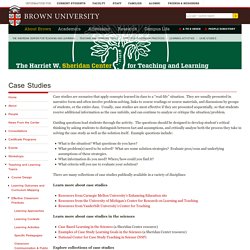
They are usually presented in narrative form and often involve problem-solving, links to course readings or source materials, and discussions by groups of students, or the entire class. Usually, case studies are most effective if they are presented sequentially, so that students receive additional information as the case unfolds, and can continue to analyze or critique the situation/problem. Guiding questions lead students through the activity. The questions should be designed to develop student’s critical thinking by asking students to distinguish between fact and assumptions, and critically analyze both the process they take in solving the case study as well as the solution itself.
Example questions include: What is the situation? Teaching Materials Using Case Studies. By Claire Davis and Elizabeth Wilcock Why This Guide?
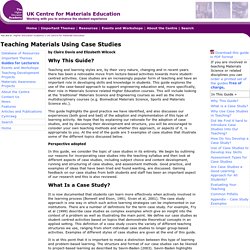
Teaching and learning styles are, by their very nature, changing and in recent years there has been a noticeable move from lecture-based activities towards more student-centred activities. Case studies are an increasingly popular form of teaching and have an important role in developing skills and knowledge in students. This guide explores the use of the case-based approach to support engineering education and, more specifically, their role in Materials Science related Higher Education courses.
This will include looking at the 'traditional' Materials Science and Engineering courses as well as the more multidisciplinary courses (e.g. Work scrutiny – What’s the point of marking books? Marking is an act of lovePhil Beadle If you’ve never taken part in a whole school book scrutiny, I’d recommend it.
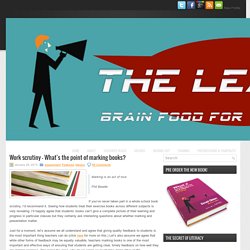
Seeing how students treat their exercise books across different subjects is very revealing. I’ll happily agree that students’ books can’t give a complete picture of their learning and progress in particular classes but they certainly ask interesting questions about whether marking and presentation matter. Just for a moment, let’s assume we all understand and agree that giving quality feedback to students is the most important thing teachers can do (click here for more on this.) Let’s also assume we agree that while other forms of feedback may be equally valuable, teachers marking books is one of the most important and effective ways of ensuring that students are getting clear, timely feedback on how well they are making progress. AfL tools. The purpose of AfL is to develop your pupils as self-regulated learners including the ability to self-assess their work and to become motivated to work independently.
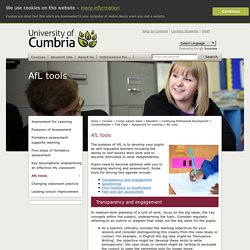
Pupils need to become partners with you in managing learning and assessment. Some tools for driving this agenda include: Transparency and engagement In medium-term planning of a unit of work, focus on the big ideas, the key concepts within the subject, underpinning the topic. Consider regularly referring to an outline or diagram that maps out the big ideas for the pupils.
As a teacher, critically consider the learning objectives for your lessons and consider distinguishing this clearly from the case study or context. The most common step that teachers miss out is the opportunity for pupils to improve their work in response to feedforward. Questioning. Regulations and Guidance - JCQ Joint Council for Qualifications.
Peer assessment. Feedback. IVITA Learning. A lot of the skills (and acronyms) apply equally to the TAQA and AET qualifications.
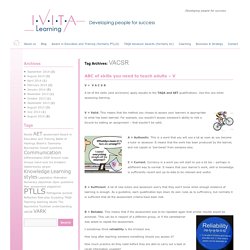
Use this one when assessing learning. V = Valid. This means that the method you choose to assess your learners is appropriate to what has been learned. For example, you wouldn’t assess someone’s ability to ride a bicycle by setting an assignment – that wouldn’t be valid. A = Authentic. C = Current. Reflective Teaching. The Unit of Education. If you cannot measure it, you cannot improve it.Lord Kelvin A lot of education research is an attempt to measure the effects of teaching (or teachers) on learning (or pupils.)

But is this actually possible? Let’s first think about measurement in a very practical sense. Schools limit admission based on a sometimes very strict catchment area – if you want to make sure that your children attend a particular school you need to live within the catchment. For some very oversubscribed schools this can be a radius of less than a mile. In order to work out how close, we agree on a measurement system and measuring devices which enable us to define the criterion of being within or outside the catchment area. Remember the scene from the film Spinal Tap where guitarist Nigel Tufnel proudly demonstrates a custom-made amplifier whose volume control is marked from zero to eleven, instead of the usual zero to ten?
Assessment. Assessment makes teaching into teaching.

Mere presentation—without assessment of what the learners have made of what you have offered them—is not teaching. So assessment is not a discrete process, but integral to every stage of teaching, from minute to minute as much as module to module. And informal assessment (or evaluation) is going on all the time. Every time a student answers a question, or asks one, or starts looking out of the window, or cracks a joke, he is providing you with feedback about whether learning is taking place. It's more an evaluation of the teaching session than about his learning, but the two are inextricable. Teacher Educator UK - Assess and Evaluate.
Assessment Matters. 3/ 3.5 Explain how to minimise risks through the planning process. Learning Outcome 3 – Understand how to plan assessment 3.5 Explain how to minimise risks through the planning process.

62144_Gravells__Chapter_1.pdf. Explain Legal Issues, Policies and Procedures Relevant to Assessment - College Essay - John1956. … and other odds and sods as they arise. Forms of Assessment. Engage in Assessment - An online toolkit enabling staff to enhance all aspects of assessment. Assessment. Formative assessment Carried out throughout the course (or at various stages); can be used as a diagnostic aid -applied by the student for purposes of self-assessment - or by the tutor in order to provide feedback.
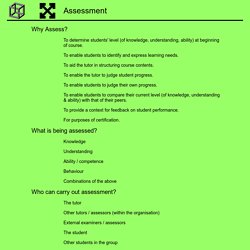
Formative assessment - Google Slides. R796. Timing your assessments - Planning and assessment design - Assessment design - Engage in Assessment. Event: Assessment in Lifelong Learning. Assessing Learning in the Lifelong Learning Sector Achieving QTLS Series: Amazon.co.uk: Jonathan Tummons: Books. Trade in your item Get a £6.82Gift Card.
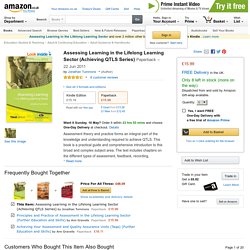
Flip to back Flip to front Listen Playing... Paused You're listening to a sample of the Audible audio edition. Learn more See this image Want it Sunday, 10 May? <div> Assessment theory and practice forms an integral part of the knowledge and understanding required to achieve QTLS. . £15.99 FREE Delivery in the UK. Frequently Bought Together No Kindle device required. Apple Android Windows Phone To get the free app, enter your e-mail address or mobile phone number. or What Other Items Do Customers Buy After Viewing This Item?
Look for similar items by category. Achieving Your Assessment and Quality Assurance Units (Taqa) (Further Education and Skills): Amazon.co.uk: Ann Gravells: 8601404222788: Books. Trade in your item Get a £6.92Gift Card. Flip to back Flip to front Listen Playing... Paused You're listening to a sample of the Audible audio edition. Principles and Practice of Assessment in the Lifelong Learning Sector Further Education and Skills: Amazon.co.uk: Ann Gravells: Books. 56 Examples of Formative Assessment. Formative Assessment » Blog Archive » Formative Assessment – Inside the Black Box. Inside the Black Box: Raising Standards Through Classroom Assessment by Paul Black and Dylan Wiliam. Methods of Assessment. Formative (Low-Stakes) Assessments Formative assessment techniques monitor student learning during the learning process. The feedback gathered is used to identify areas where students are struggling so that instructors can adjust their teaching and students can adjust their studying.
These are low-stakes assessments (i.e., they have low point values) that happen early and often in the semester. Written Reflections.